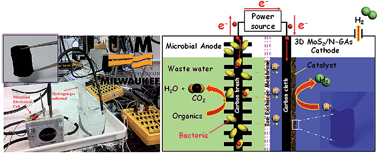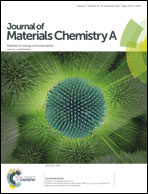A 3D hybrid of layered MoS2/nitrogen-doped graphene nanosheet aerogels: an effective catalyst for hydrogen evolution in microbial electrolysis cells†
Abstract
Cost-effective catalysts are the key to the successful deployment of microbial electrolysis cells (MECs) for hydrogen production from organic wastes. Herein, we report a novel catalyst for hydrogen evolution in MECs based on a 3D hybrid of layered MoS2/nitrogen-doped graphene nanosheet aerogels (3D MoS2/N-GAs) that were prepared by a facile hydrothermal approach. A high output current density of 0.36 mA cm−2 with a hydrogen production rate of 0.19 m3 H2 m−3 d−1 was achieved for the hybrid at a 0.8 V bias, significantly higher than that of MoS2 nanosheets and N-GAs alone and comparable to that of the Pt/C catalyst when being applied in MECs. The outstanding performance of the hybrid benefits from its 3D conductive networks, porous structure, and strong synergic effects between MoS2 nanosheets and N-GAs, making it a promising catalyst for hydrogen production from wastewater through bio-electrochemical reactions.


 Please wait while we load your content...
Please wait while we load your content...